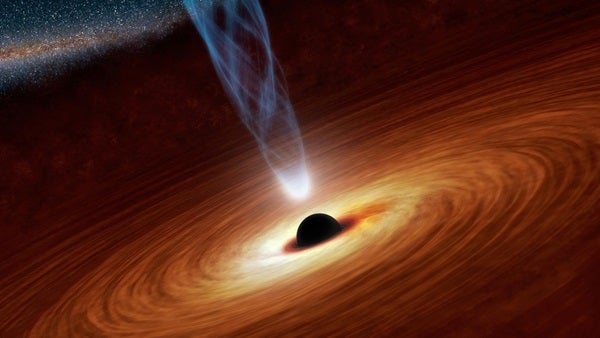Q: Are black holes spherical? If so, does a black hole’s singularity sit at the center of a surrounding event horizon “shell”?
A: In 1916, Karl Schwarzschild calculated the simplest type of black hole: a central singularity surrounded by a spherical event horizon whose size is proportional to the black hole’s mass. (Anything, even light, that crosses the “event horizon” cannot escape.) In addition to mass, electric charge and spin are the only other properties a black hole can have.
We expect that black holes in the universe spin but do not have significant electric charges. If one of these extreme objects becomes charged, it will immediately attract particles with the opposite charge to stay neutral.
Black holes either can be born with spin, like if they form from the collapse of a rotating massive star, or can acquire spin from the rotational energy of infalling gas. We think spinning black holes have “ring”-shaped singularities; their exotic properties have even led some to consider using black hole interiors as “wormholes” for time travel. The event horizons of spinning black holes are flatter along their equators (like both Earth and Jupiter are flatter along their equators). A higher rotation rate means this flattening is more pronounced. Although a spinning black hole has no actual rotating surface around it, the surrounding space is twisted in the direction of rotation and dragged along with the spin.
Astronomers attempt to measure the rotation values of black holes by studying the radiation from gas orbiting near their event horizons. Material around a more rapidly spinning black hole orbits closer to the event horizon, where it becomes hotter and emits light that is severely distorted by a black hole’s strong gravitational pull. Measuring these effects provides us with estimates of black hole spin, which tells us how these objects form and grow and gives us hints about the shape of the surrounding space, including black holes’ event horizons.
University of California, Berkeley










